Updated Sunday, Oct. 4, at 08:39 EST
TAKEAWAY: Now that the United Nations has granted the tango its well deserved recognition as a musical form and dance style that must be preserved for its contribution to the world’s popular culture, I think it is time to campaign for the mambo, also deserving of such honor. For me, the mambo is the sound of my childhood. Let the “preserve the mambo” campaign start here. SUNDAY UPDATE: Jacky’s picks from Bild Am Sonntag


Front page of today’s Bild Am Sonntag

The baby rhino and its babysitter

A story about polar bears: Love is in the Bear, reads the headline

Interview with NADJA BENAISSA ex member of a girls’ singing group who declares she is HIV positive.
It is no surprise that Jacky’s picks for this Sunday are all about animals: a bear, a rhino. Animal stories are a main ingredient in the content mix of the Bild Am Sonntag each Sunday. A double page interview/story is about a former member in an all girls’ singing group that declares that she is HIV+.
More than 40 years ago I heard the editor of an afternoon Florida newspaper offer his guarantee for content success: Make sure you have pictures of babies, animals and pretty girls. Rather simplistic,and somewhat politically incorrect formula, but Bild am Sonntag seems to adhere by it to this day.
Who is Jacky?
Jacky belongs to Frank Deville. The Luxembourg-based pooch is an “avid reader” of the German newspaper, Bild Am Sonntag. Every Sunday Jacky picks stories and interesting graphics in Bild Am Sonntag , the German newspaper.
Mambo was a good lullaby
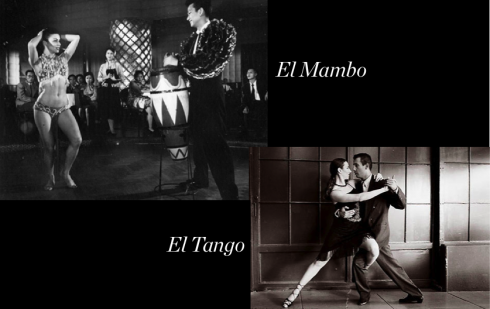
As someone who likes the tango very much, I am happy that such recognition has come to that most sensual of dances.
It is, indeed, absolutely great that the United Nations is declaring the sensual dance and musical form part of the world’s cultural heritage.
However, I also think that the mambo should receive equal recognition, and I mean that seriously. Perhaps we need to start one of those Facebook campaigns, gather enough signatures and get things in motion, mambo style, of course. If the tango can get the recognition, so can the mambo, which historians say was introduced by that mambo maestro Damaso Perez Prado at Havana’s legendary Tropicana Night Club in 1943.
The Mambo and Me
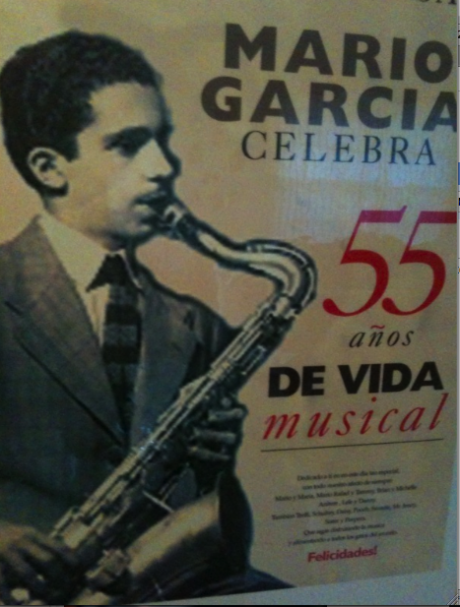
My own Mambo King: My Dad, Mario Garcia, here in a Miami poster celebrating his 55 years as a saxophone player. My father played with a then virtually unknown Damaso Perez Prado in his island tour of 1941
When I propose the mambo for United Nations recognition, I am honoring a part of my childhood, indeed. My late father, Mario Garcia, was a saxophone player in the Havana of the 1950s, and later in Miami of the 60s. My dad played gigs till about one week before he died in 2002. You could not be a musician at Havana’s Tropicana night club and not have el mambo as one of the first musical styles in your repertoire.
My early recollections of the mambo take me to 1958. Let’s put it this way: The mambo was probably my lullaby. All one could hear in any corner of Havana were the “get me moving” sounds of perhaps the most famous of mambos: “Que Rico el Mambo” (How Delicious the Mambo). As a child, I remember that the loud sounds of this mambo would emerge like happy sirens from all those streetcorner bars, where men sat on tall stools, sipping Cuba LIbres while a pretty waitress smiled behind the bar.
My Mom in Miami, with whom I am visiting this weekend, reminds me that my dad was playing with Damaso Perez Prado when the then unknown musician conducted a tour of the entire island of Cuba in 1941.
At home, my dad rehearsed the mambo on his tenor saxophone to warm up for his nightly performances at the Tropicana.
So I would sit in my room, studying English verbs (“why is it “ran” and not “runned”?) while the sound of the sax in the next room was a sequence of stops and starts, practice style, for Mambo Que Rico El Mambo.
Did I grow up with the mambo? Yes.
Did most Cubans of my generation grow up with the mambo? Yes.
Did I have more of a mambo overdose because of my dad’s profession? Of course. Who said an overdose could not be fun?
The mambo, say the musical experts, is a fusion of Cuban-African music (think rumba), jazz, Hip-Hop, even some ballet. When danced propertly, it is quite athletic, and I am surprised that mambo is not used more often in fitness clubs around the world as the ultimate work out.
The Mambo is more than just a dance
The Mambo is a pure expression of the Caribbean. The word mambo sounds like some tropical fruit. It invites you to move. To see a Cuban mulatta doing the mambo is to be in the presence of moving art—-uncensored, unrehearsed, undefineable. Real mambo is never choreographed; it is an organic, instinctive form of movement that you simply can’t learn at the Fred Astaire Dance School.
Perhaps the mambo was one of Cuba’s greatest exports, and sweeter than its official one: sugar. When the mambo came across the water and landed on the two-toned shoes of New Yorkers, that musical form took off in all directions. From time to time, that most famous Cuban of all to Americans of the 50s, Desi Arnaz, would lead his orchestra at the fictitious Club Babalú into a mambo. In 1999, the Oscar Hijuelas
novel, The Mambo Kings Play Songs of Love, won high praise from critics and was made into a movie, where Desi Arnaz Jr. played his famous dad.
Mambo and Tango
There is no point in comparing the Caribbean-influenced mambo with the more melancholic tango. And, in fact, my colleague Rodrigo Fino, of Garcia Media Latinoamerica, and I, have engaged in conversations about this through the years.
Our chats on the subject always led to the well known stereotypes: the super energized Cuban and the melancholic Argentine, two very different kind of people, but who, through the years, have always shown an affinity for each other. Think Fidel Castro and Che Guevara.
Rodrigo and I often wonder how those dialogs between Fidel and Che, up on a Cuban mountain, would have gone. Legend has it that Fidel would sip one little Cuban coffee after the other, while smoking his cigar; meanwhile, Che would enjoy a good mate, which, unlike cafecitos cubanos, is made to be consumed slowly.
Is it possible that Fidel and Che engaged in a real conversation about mambo and tango, like Rodrigo and I often do?
Rodrigo reminds me today that long before Che Guevara became the revolutionary who joined Fidel in the Cuban mountains—-and decades before he turned into rock star cult level celebrity——he and some friends took a small homemade boat down the Amazon River. Name of the boat: Mambo-Tango.
Let’s hear it for the mambo
I hereby open the doors for a real good mambo campaign. Let the mambo be the next sensual musical form to get recognized as a cultural powerhouse that must be preserved.
At Yale University this semester a course is offered dealing with the history of the mambo and other similar musical styles. Our own Reed Reibstein is taking that class, and I hope he will give us a course update at the end of the semester. The Yale course is titled NEW YORK MAMBO: MICROCOSM OF BLACK CREATIVITY
That night in 1958 at the Tropicana Night Club
Finally, the mambo does bring up the memories. It was probably a night in 1958, and I was 11 years old. My dad had taken me to the nightclub, and I was doing a little “exploratory” tour of the dressing rooms backstage. Suddenly, a statuesque chorus girl started walking towards me, all ready for her performance. I saw feathers of all colors as part of her head dress, a very tall one. I saw extremely high heels shining like millions of diamonds at her feet. She wore a tiny glittering bikini, and, what I remember most: only glitter, tons of it, to cover her nipples.
“Hi, bebito,” she called. “You ready to mambo?”
I was then. I am now.
Al Pacino doing the tango in Scent of a Woman (1992)
Carlos Gardel sings the most beautiful tango El Dia Que Me Quieras
Perhaps the most famous mambo: Que Rico el Mambo
See Perez Prado’s Mambo #5
Rio de Janeiro wins the day!

These two front pages from The Chicago Tribune and Rio’s O Dia tell the story in very graphic terms: Chicago lost its bid for the 2016 Olympics; it will be a big carnival in Rio in 2016, first time a South American city hosts the Olympics.
2015 Newsroom: Highlights of the WAN/IFRA seminar in Prague
TAKEAWAY: The WAN/IFRA conference in Prague, devoted to the 2015 Newsroom closes today. I was a keynote speaker yesterday and offer highlights of my participation here. Of special interest: FUTUROOM, an almost perfect prototype for the newsroom of the future
Highlights of the conference
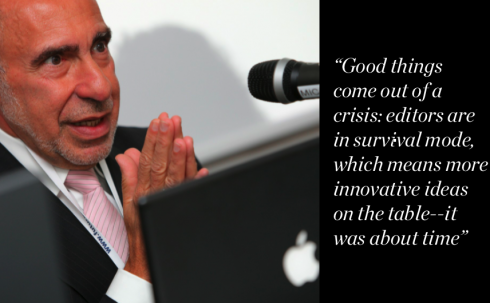

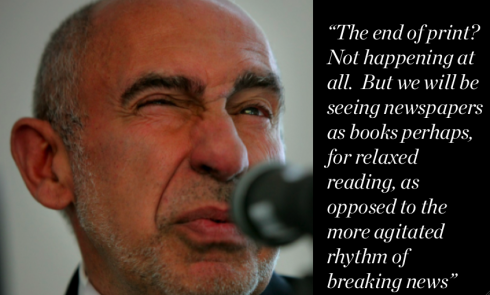
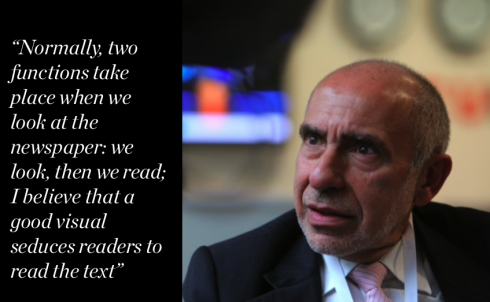
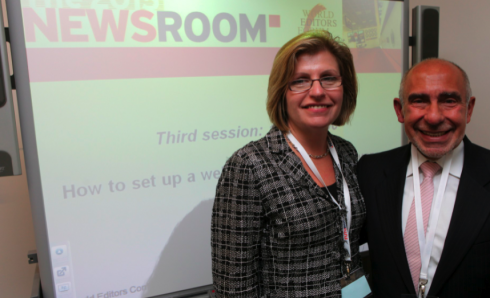
With WAN/IFRA’s Martha Stone (my former student at the University of South Florida), now Director/Shaping the Future of the Newspaper
All photos courtesy of Ond?ej Besperát/PPF Media, Czech Republic
Mine was a whirlwind visit to Prague and to the WAN/IFRA Conference where I keynoted the afternoon session titled: Visual journalism: the rise of non-narrative news.
I shared the session with Robb Montgomery, consultant and founder of Visual Editors.com, and Joerdis Guzman Bulla, art director of the award winning Welt Am Sonntag of Germany.
This was a session where visual journalism was presented as a multiplatform storytelling form of expression. Both Montgomery and Guzman Bulla emphasized the importance of visual journalists who move across the platforms. Many examples proved the point.
For me, my visit to the conference included three particular highlights, which I wish to share:
Highlight #1—The dialogs over coffee
We all know that the best part of these conferences is usually the coffee break, the quick exchange of valuable ideas with colleagues.
I found myself having a delightful conversation with Santiago de la Mora, Google’s head of print content partnerships (based in London), and Xavier Vidal-Folch, adjunct editor of El Pais of Madrid.
This conversation was about the timely subject of how Google and traditional newspaper houses can connect synergies. And, of course, the conversation turned to ownership of information, and how both parties can benefit from how such information is presented and paid for.
My take on this, and a message to De la Mora: I think that there is great potential for Google and newspapers to form profiteable and exciting partnerships, but Google perhaps needs to come closer to newspapers and learn how newspaper editors think.
Highlight #2: FUTUROOM
FUTUROOM is an interesting concept for anyone interested in the future of media. Based in Prague, this FUTUROOM is a newsroom like I had not seen before. No walls, no divisions according to print or digital, and an environment in which news/storytelling can prevail without the usual obstacles that we find in more traditional settings. It was interesting to see the signs hanging from the ceiling, in lower case: watch dog, investigative, etc.That is as close to “partitions” as anyone could come. Let’s keep an eye on FUTUROOM.
Highlight #3: The Robb Montgomery Movie
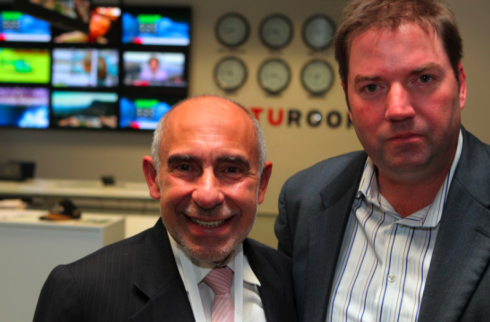
Meet the director: Robb Montgomery and me in the middle of the FUTUROOM set.
Well, Michael Moore,
move over. Now Robb Montgomery is actually making a movie about our industry in crisis (I told him I prefer to call it an industry in transition).
So Robb put me in the film, thank you. There he was, in the middle of the FUTUROOM —-our set——setting up the tripod, and adjusting a mike on my lapel, and shooting questions at me.
Here is how Robb describes his movie project:
I have been filming interviews with journalists around the world to document this uncertain period in journalism’s history and I have a vision to direct a feature-length documentary film. I have some great interviews made already and the film will be produced by Visual Editors as a grant and public-funded project. Why? Because VizEds is a 501(c)(3) charity and can appeal to funders with a unique pitch. One part historic marker in time, one part jobs program and one part educational. Already have some strong interest and I hope maybe you can help me get the project noticed for people who like to support this kind of effort.
The plan, says Robb, is to get enough money so that he can hire out of work journalists to contribute scripts, stories, photos and more to help tell this story from the inside out.
There is so much to report and film is a great medium to reduce a multi-year event like this in powerful and concise story.
It’s a three-year project and I think I am lucky to have a unique position and global network of journalists and publishers to who will want to take part.
I am quite interested on how the rest of Robb’s movie develops, and will update you here.
TheMarioBlog post #386